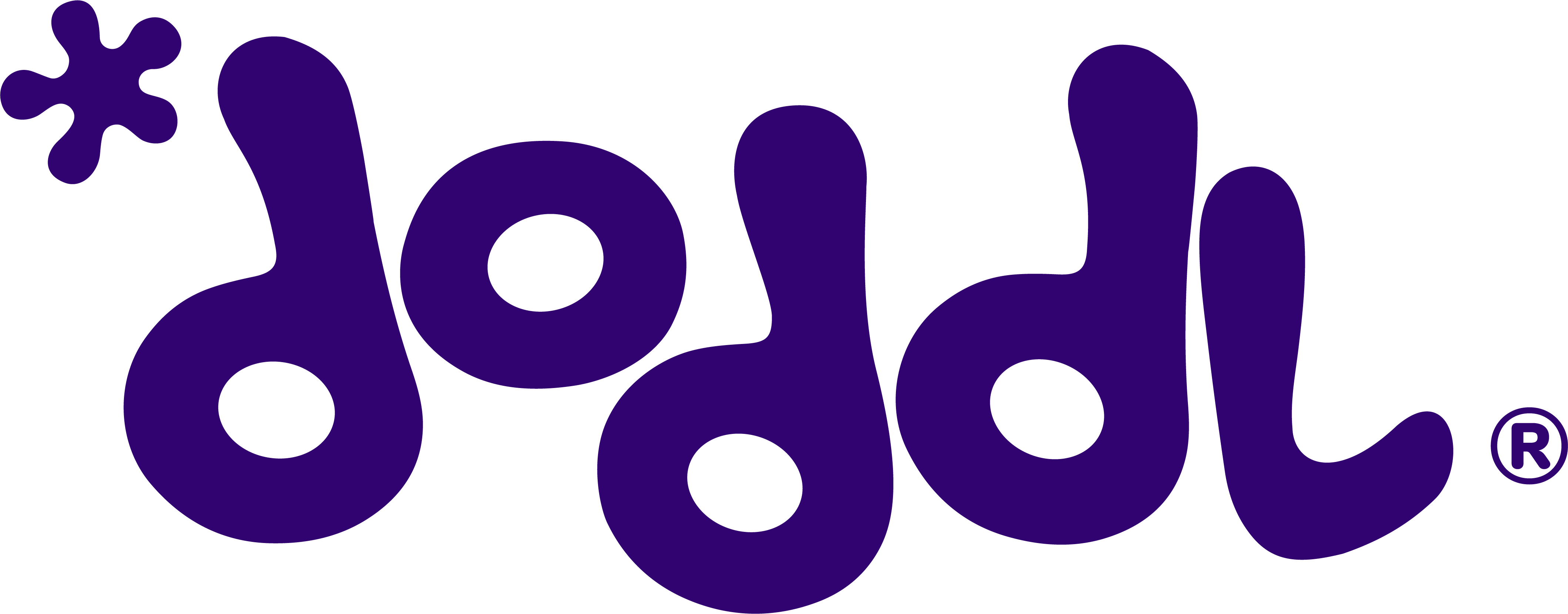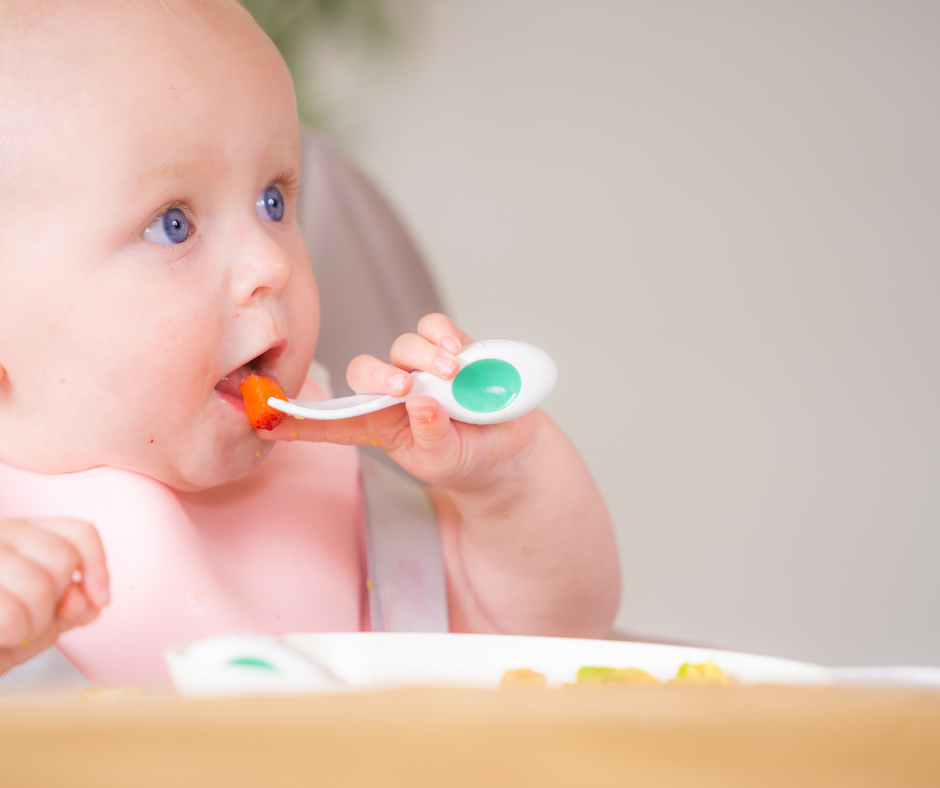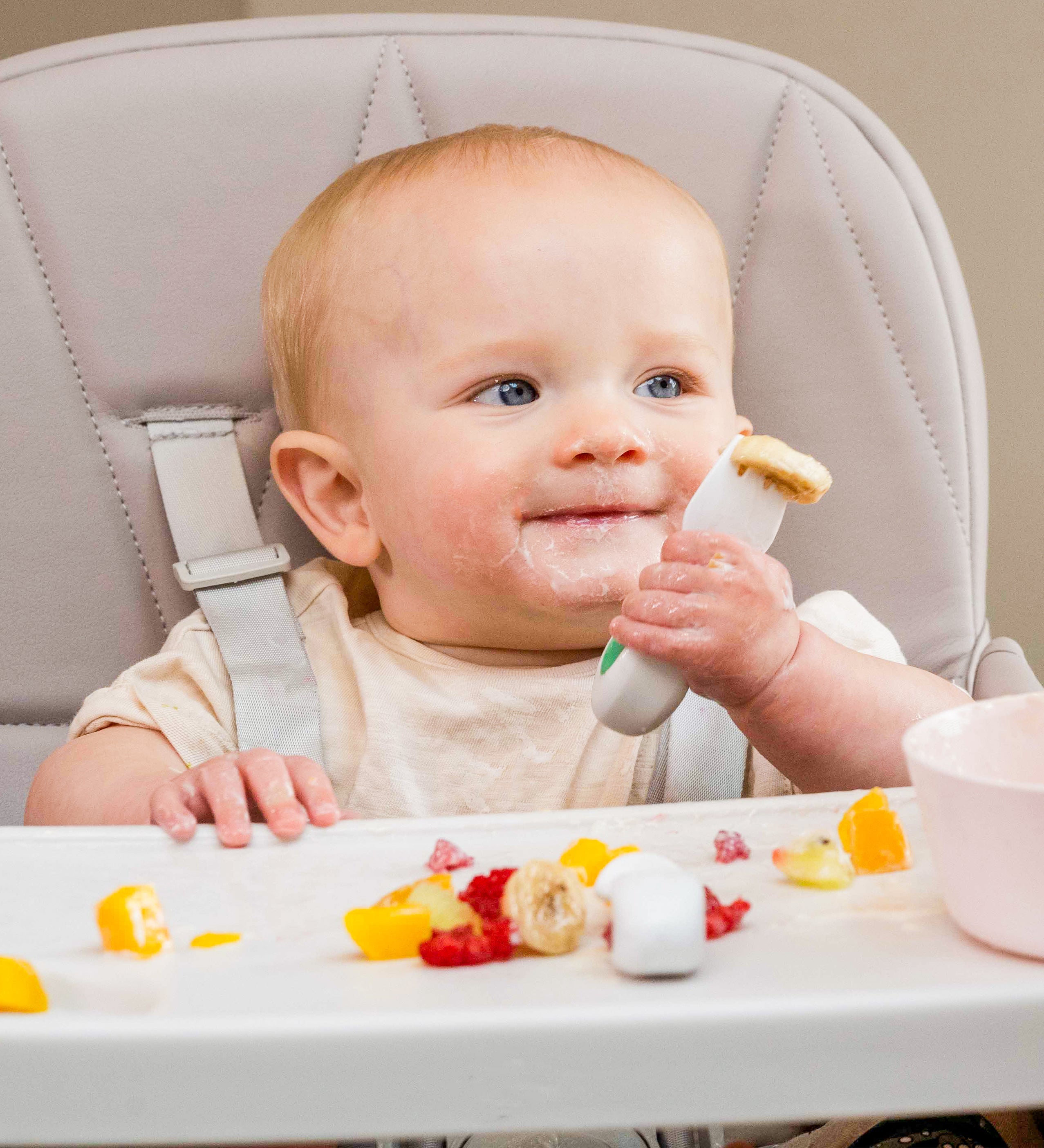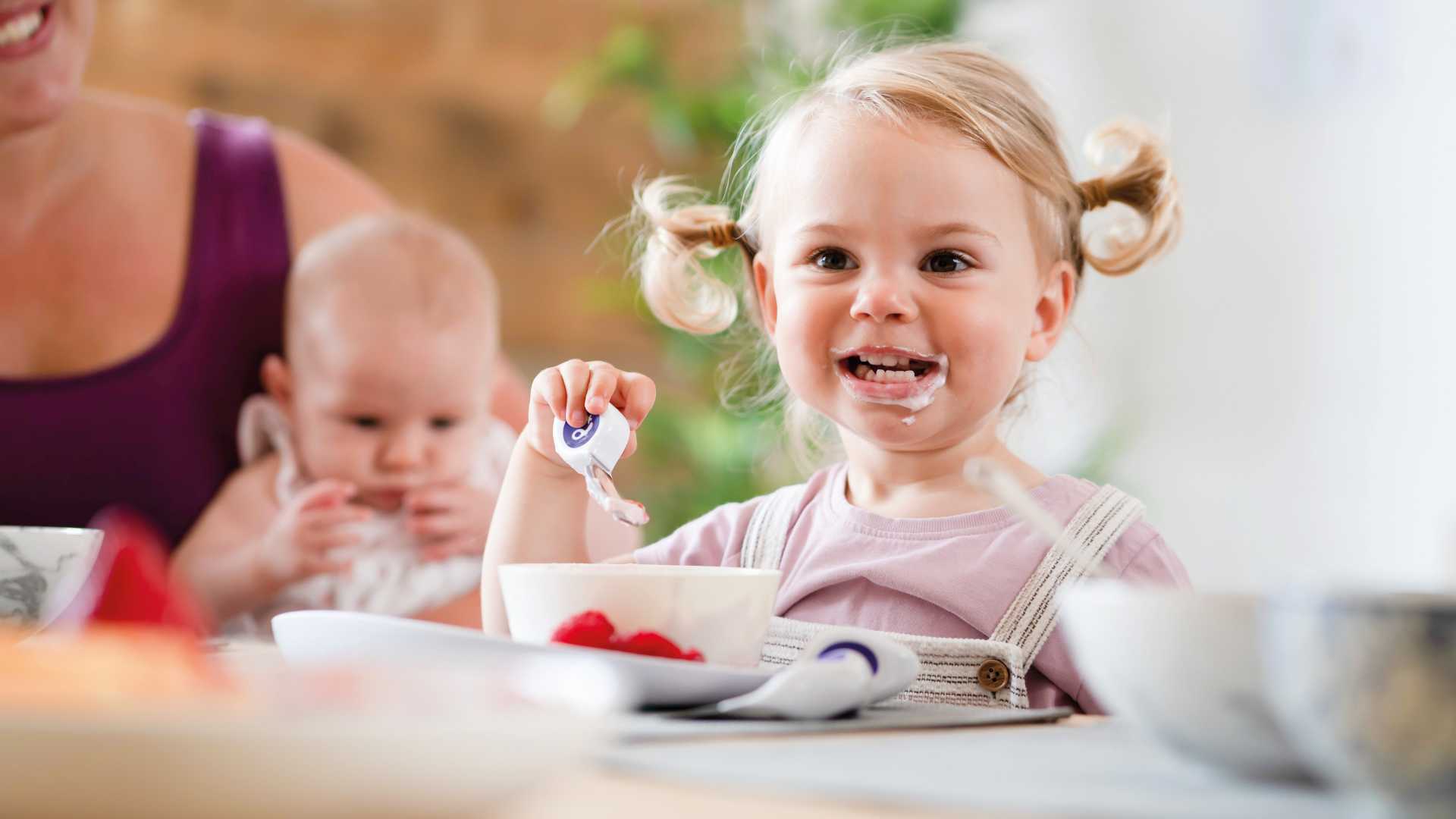Your baby is growing up! For new parents, transitioning from milk to solids is both exciting and stressful. Introducing solid foods to your baby is scary - if you are like me, you probably worry that your little one might choke.
Imagine the entire transition of going from milk to solids with your baby as adding an extra layer to your baby's diet. Rather than replacing what they already enjoy and rely on (breast milk or formula), you are simply adding to their meal menu. You are not going to stop breast milk or formula but only introduce a variety of solid foods.
Transitioning your little one from milk to solids will involve a lot of messy faces, a few puzzled expressions, and plenty of laughs. When I transitioned my two children from milk to solid foods, I was a nervous wreck but I went slow and just had fun with the process. I wanted it to be a positive experience for both of us!
In this article, we’ll explore the process and tips on how to safely introduce solids to your baby’s diet.

When to Start Introducing Solid Food
The big day has arrived - it's time to start feeding your baby ‘real’ food. One of your baby’s first (and most exciting) milestones is when you transition from milk to solids. This process usually starts when your baby is around six months old.
Never give solid foods to a baby younger than six months old - their little tummy can’t handle the task of digesting such foods.
Is your baby ready for solids? You might want to ask the advice of your pediatrician before making the leap. There is nothing wrong with double-checking by making a quick visit to the doctor’s office.
The U.S. Centers for Disease Control and Prevention provides guidelines on when, what, and how to introduce solids here.
Smoothly Transition from Milk to Solids

Begin with a calm and familiar environment, ideally when your baby is not too hungry or too full. Offer only a couple of spoonfuls of single-ingredient puree or infant cereal mixed to a very thin consistency.
Use the doddl baby spoon, which is a soft plastic spoon, to gently offer the food, and don’t be discouraged by funny faces or outright rejections; this is all new to them. Just take things slow and don’t be alarmed that your baby spits out more of the food than they eat - it's perfectly natural.
Morning is often a good time for this new activity, as it allows you to watch for any reactions to new foods introduced.
Readiness for solid foods always depends on your baby’s development progression. No two babies are exactly alike. Some will advance more rapidly than others.
Why Wait Until Around 6 Months to Introduce Solids?
Waiting until your infant is around 6 months old gives your baby’s digestive tract the amount of time needed to truly mature so it can better cope with solid foods.
Also, introducing foods too early to a baby can increase the chance of your little one developing an allergy, choking, obesity, and more.
Remember, there is no reason to rush any childhood development milestone. Your baby will reach the milestones when they are ready. Instead of trying to rush things along, sit back and relax. Enjoy your child’s time as a baby.
Before introducing solids to your baby’s diet, your little one should be able to physically support themselves and truly be ready to transition from milk to solid foods.
Not all babies make the same milestones at the same age. There is no reason to push what your baby isn’t ready to do. Instead, relax and take your time - you aren’t running a race to hit each milestone.
If you are in doubt about whether your baby is ready for solid foods, reach out to your pediatrician to discuss your baby’s unique circumstances.
Signs Your Baby is Ready for Solid Foods
Signs to watch for to determine if your baby is ready to take that first bite include:
- Being able to sit up without any support.
- Exhibits proper head control.
- Starts chewing on toys, hands, and other items.
- Shows a curiosity about food such as watching you eat or eagerly reaching for a bite of food.
- Opens their mouth at the sight of food.
How to Start Solid Foods

The big day has arrived - you’ve decided your baby is ready to transition from milk to solids. However, you’re probably left wondering what are the best first foods for a baby.
- Begin with single-ingredient, iron-fortified cereals or pureed fruits, vegetables, or meats.
- Offer one new food at a time.
- Wait 3-5 days before introducing another food choice to monitor for allergic reactions.
- Initially, only start with a few teaspoons once a day. You don’t want to overwhelm your baby’s digestive system.
- Gradually increase the amount based on your baby's interest and appetite.
Play it safe and pick only iron-rich foods because a baby’s iron reservoir starts to deplete around six months old and can use a recharge with an iron-rich diet. This is why most start feeding their baby iron-fortified single-grain baby cereals mixed with either water, breast milk, or formula. However, with the baby-led weaning approach you start your little one out with finger foods - we’ll cover more about that method later in this article.
Once your baby adjusts to the cereal, it's time to try something new. Ideally, you should introduce only single-ingredient baby foods and then wait about five days. This is the wait-see method so you can make sure the food doesn’t upset your little one’s tummy.
Many parents opt to feed pureed/mashed fruits or vegetables or they use commercial baby foods. Most will wait before feeding any kind of pureed meats or poultry because such foods are harder on your little one’s digestive tract.
Texture Progression
Once your baby starts to master the different first-step baby foods, it's time to explore textures. You can go from pureed to mashed and then eventually on to finely chopped foods as your baby’s ability to successfully chew and swallow advances. However, don’t go too fast, and always consult with your pediatrician before making any big leaps.
Safety and Hygiene

Never leave your baby alone to eat. Always supervise every bite and keep an eye on your little one while they eat to prevent choking.
Maintain cleanliness by washing your hands before you prepare any food or feed your baby. You should also ensure that all cooking utensils and food containers have been cleaned and sterilized between each use.
Do not feed any baby honey before age one. Introduce allergenic foods (like peanuts, eggs, and fish) in small amounts after other solids have been successfully introduced and tolerated. Always watch closely for any signs of an allergic reaction, including hives, rash, or digestive issues.
Equipment Checklist
- High chair with a secure safety strap
- Small, baby-sized spoons made of soft material by doddl.
- Baby suction bowls to stay in place
- Bibs, preferably waterproof or easy-to-clean
- Storage containers for homemade purees
- Blender or food processor for making purees
Feeding Your Baby: From 0 to 6 Months
From birth to around 6 months, babies should be exclusively breastfed or given formula. Breast milk or formula provides all the necessary nutrients for growth and development during this period.
Feeding Your Baby: From Around 6 Months

Introduce solid foods while continuing to feed breast milk or formula.
Start with iron-fortified cereal or pureed vegetables, fruits, and meats. Gradually increase the variety and texture according to your baby's readiness.
Below are 10 of the best first foods for babies. Again, what works for one baby might not for another. Many parents like to avoid fruits initially because they feel it encourages a sweet tooth in their little one and makes the baby refuse vegetables, but others like to provide their baby with a variety.
1. Iron-Fortified Single-Grain Cereals
Many pediatricians recommend rice cereal as a good first solid food choice for your baby because it's fortified with iron. However, you can also opt for oatmeal or barley. Some commercially prepared baby cereals also contain bananas or apples to make them more appealing. You can also mash a little of the fruit into the cereal.
2. Smooth and Creamy Avocado
Avocados have a wonderful creamy texture and are loaded with healthy fats that promote brain development. If you are looking for a natural food and want to veer away from commercial baby foods then avocado is often a great starting point for transitioning from milk to solids.
3. Classic Sweet Potato
Sweet potatoes are another classic first baby food choice. They are high in vitamins A and C, fiber, potassium, and beta-carotene. Also, sweet potatoes are easy to digest. Just remember to puree them into a very smooth texture.
4. Yummy Bananas
Bring out the monkey in your baby with bananas. Most babies love bananas as a first solid food choice. Mash the banana so it's very creamy and smooth before offering it to your baby.
5. Applesauce
If you are not feeding a commercially prepared applesauce baby food then choose an unsweetened applesauce brand or go with a homemade variety. Applesauce is a great source of both fiber and vitamin C.
6. Pears
Pears are wonderfully gentle on your baby’s tummy while being high in fiber. You can steam and puree the pears to have a smooth consistency.
7. Peas
Most babies like peas because they have a sweet flavor. A perk about peas is that they are loaded with vitamins A, C, K, and B. They also provide protein and fiber to your baby’s diet.
8. Carrots
Turn on an episode of the classic cartoon Bugs Bunny and introduce your baby to carrots! Carrots can have a high amount of beneficial beta-carotene and they are usually the favorite first food choice for babies.
9. Squash
Pick acorn or butternut squash rich in vitamin C and beta carotene. Steam the squash or roast it and then puree it into a smooth consistency.
10. Meats and Poultry
Chicken, turkey, and beef pureed are favorites because they are loaded with needed iron and protein. Many breastfed babies will benefit from the added iron.
Baby Finger Foods
Introducing baby finger foods is all about watching your baby’s motor skills and chewing ability. You don’t want to introduce finger foods too early.
Ideally, first baby finger foods include commercially prepared biscuits and soft-cooked meats. However, with baby-led weaning, you’ll introduce a bevy of veggies, fruits, dairy, and more.
You can also use soft cooked vegetables and ripe fruits. Always make sure that all foods are soft and easy on the gums. Cut the finger foods into small pieces to avoid any risk of choking.
Baby-Led Weaning
Lately, more and more parents are skipping the spoon-feeding stage and jars of baby mush in favor of a trendier, hands-on approach for their little munchers. Welcome to the world of baby-led weaning, where tiny fingers take the lead in the food adventure, allowing babies to explore and choose their bites from a lineup of baby-friendly finger foods.
Big across the pond in the U.K. and now making waves in the U.S., baby-led weaning is all about letting babies try solid foods with finger foods right from the get-go (yes, bypass the purees and mash), once they hit the 6-month mark.
This process is considered a self-directed way of transitioning from milk to solid foods. You let your baby take charge of their eating journey.
It's a great way to let your baby decide when they are hungry and how much they eat.
And there's more to love about baby-led weaning. Babies get to enjoy textures and tastes. Also, with baby-led weaning, your little one decides when they are full.
Eating with their tiny hands also improves your baby's motor and hand-eye coordination by encouraging your baby to grab and explore their foods.
When undergoing baby-led weaning, you'll want to choose soft, easily gummed foods cut into manageable pieces. Think ripe fruits, steamed vegetables, and small pieces of soft-cooked meat.
During baby-led weaning, offer water in a cup during meals to help your baby learn to drink from a cup and stay hydrated. Finger foods lack the moisture found in pureed and mashed foods, so offering water in an open cup is ideal.
The Michigan Department of Health and Human Services released an informational flyer about baby-led weaning here.
Time to Offer Baby Food Variety
Your baby seems to have mastered solids - now it is time to start combining foods so your little one can experience a variety of new tastes and textures.
During mealtimes, you can start to include a little fruit, vegetables, grains, and meats so your baby has full access to a variety of nutrients. Have fun making a yummy combo to tantalize your baby’s taste buds. For inspiration check out our baby weaning recipes.
Encourage Self Feeding

Once your baby becomes skilled at eating then it's time to encourage self-feeding. Be sure to chop up the foods into very small pieces to avoid any potential choking hazards.
When using the baby-led weaning approach, serving food is all about making it manageable and safe for your little one to explore and eat on their own.
Offer foods in shapes and sizes that your baby can easily grasp in their palm or fist. Longer, stick-shaped pieces that protrude from their hand are ideal.
It is also essential to consider the texture; foods should be soft enough to squish between your fingers to prevent choking hazards. Ideal baby lead finger foods include soft fruits and veggies such as mango, banana, oranges, zucchini, and more
You should also make sure that the foods you are offering your baby are easy on the gums.
Let the Baby Food Introductions Begin!
Okay, it's the big day. Your baby is six months old and meets all of the criteria so you can safely start transitioning from milk to solids. Our guide has helped you make your choices on the first foods to feed your baby.
Remember, every baby is different, so be patient and flexible. Your baby may eagerly accept one food and reject another, or enjoy a food one day and refuse it the next. This is normal.
The process is all about baby steps, quite literally. Initially, solid food is more about practice than nutrition, which is why it's introduced slowly alongside their regular milk feedings. You'll start with thin, single-ingredient purees.
Over time, as your baby becomes more comfortable and skilled at eating, you'll introduce thicker purees, then mashed foods, and eventually, small, soft pieces of finger foods.
Transitioning to solids is a significant milestone, so take lots of pictures, be patient, and enjoy this special time with your baby. Check out How to Wean a Baby for more info.
Every child's journey is unique, and there's no one-size-fits-all approach. Trust your instincts, and don't hesitate to reach out to your pediatrician with any concerns or questions. Happy feeding!
When your baby is ready to transition from milk to solids, it’s time to invest in toddler utensils that have been specially designed for children who are 12 months plus to learn to eat independently! All of the doddl products are comfortable to use and help your little one develop their motor skills so they are better ready to eventually transition to adult flatware.





Leave a comment
This site is protected by hCaptcha and the hCaptcha Privacy Policy and Terms of Service apply.